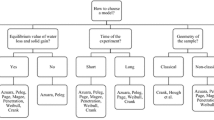Abstract
Sodium chloride salt is used in the cheese salting because it promotes sensorial changes besides preserving the food, but in excess can cause hypertension. Therefore, it has been partially replaced by potassium chloride to not affect the sensory characteristics. In this work the mozzarella cheese was subjected to the diffusion of Na+ and K+ in brine by static and stirred immersion. The diffusion was modeled using the second law of Fick and simulated by the finite element method through the software COMSOL Multiphysics® version 5.2. The main, cross coefficients and the relation between mass transfer coefficient and the mass conductivity were determined through simplex optimization, minimizing the percentage errors between the experimental and simulated concentrations, obtaining 3.79%(w/v) for NaCl and 5.66%(w/v) of KCl in static brine. In stirring brine, the errors obtained were 5.40%(w/v) for NaCl and 6.01%(w/v) for KCl. The resulting main diffusion coefficients were 1.12 × 10−9 (m2/s) for NaCl and 0.91 × 10−9 (m2/s) for KCl.




Similar content being viewed by others
References
Paz NF, Gonçalvez De Oliveira E, Villalva FJ, Armada M, Ramón AN (2017) Effect of pH at drainage on the physicochemical, textural and microstructural characteristics of mozzarella cheese from goat milk. Food Sci Technol 37:193–201
Jana AH, Mandal PK (2011) Manufacturing and quality of mozzarella cheese: a review. Int J Dairy Sci 6:199–226
Gómez-Salazar JA, Clemente-Polo G, Sanjuán-Pelliccer N (2015) Review of mathematical models to describe the food salting process. Dyna 82:23–30
Guinee TP, Fox PF (1984) Salt in cheese: Physical, chemical and biological aspects. In: Fox PF (ed) Cheese : Chemistry, Physics and Microbiology, vol 1. Elsevier Applied Publ. Science, New York, pp 31–35
Albarracín W, Sánchez IC, Grau R, Barat JM (2011) Salt in food processing; usage and reduction: a review. International Journal of Food Science & Technology 46:1329–1336
Rodrigues FM, Rosenthal A, Tiburski JH (2016) Alternatives to reduce sodium in processed foods and the potential of high pressure technology. Food Science and Technology 36:1–8
Blaustein MP, Leenen FH, Chen L, Golovina VA, Hamlyn JM, Pallone TL, Van Huysse JW, Zhang J, Wier WG (2012) How NaCl raises blood pressure: a new paradigm for the pathogenesis of salt-dependent hypertension. Am J Physiol Heart Circ Physiol 302:1031–1049
Horita CN, Messias VC, Morgano MA, Hayakawa FM, Pollonio MAR (2014) Textural, microstructural and sensory properties of reduced sodium frankfurter sausages containing mechanically deboned poultry meat and blends of chloride salts. Food Research International 66:29–35
Barat JM, Baigts D, Aliño M, Fernández FJ, Pérez-García VM (2011) Kinetics studies during NaCl and KCl pork meat brining. J Food Eng 106:102–110
Borsato D, Moreira MB, Moreira I, Pina MVR, dos Santos Ferreira da Silva RS, Bona E (2012) Saline distribution during multicomponent salting in pre-cooked quail eggs. Food Science and Technology 32:281–288
Bordin MSP, Borsato D, Cremasco H, Galvan D, Silva LRC, Romagnoli ÉS, Angilelli KG (2019) Mathematical modeling of multicomponent NaCl and KCl diffusion process during the salting of pre-cooked champignon mushrooms. Food Chem 273:99–105
Angilelli KG, Orives JR, da Silva HC, Coppo RL, Moreira I, Borsato D (2015) Multicomponent diffusion during osmotic dehydration process in melon pieces: influence of film coefficient. Journal of Food Processing and Preservation 39:329–337
Bona E, da Silva RSSF, Borsato D, Silva LHM, Fidelis DAS (2007a) Multicomponent diffusion modeling and simulation in prato cheese salting using brine at rest: The finite element method approach. Journal of Food Engineering 79:771–778
Zorrilla SE, Rubiolo A (1994) Modeling NaCl and KCl movement in Fynbo cheese during salting. J Food Sci 59:976–980
Cremasco H, Galvan D, Angilelli KG, Borsato D, Oliveira AG (2019) Influence of film coefficient during multicomponent diffusion–KCl/NaCl in biosolid for static and agitated system using 3D computational simulation. Food Science and Technology 39:173–181
Ribero GG, Rubiolo AC, Zorrilla SE (2009) Microstructure of mozzarella cheese as affected by the immersion freezing in NaCl solutions and by the frozen storage. J Food Eng 91:516–520
Kosikowski F (1978) Cheese and fermented milk foods FV Kosikowski and associates. New York, NY
Furtado MM (1991) A arte e a ciência do queijo. Globo
Bona E, Carneiro RL, Borsato D, dos Santos Ferreira da Silva RS, de Fidelis DAS, Silva LH (2007b) Simulation of NaCl and KCl mass transfer during salting of Prato cheese in brine with agitation: a numerical solution. Braz J Chem Eng 24:337–349
Onsager L (1945) Theories and problems of liquid diffusion. Ann N Y Acad Sci 46:241–265
Harrington EC (1965) The desirability function. Industrial Quality Control 21:494–498
Derringer G, Suich R (1980) Simultaneous optimization of several response variables. J Qual Technol 12:214–219
Bona E, Silva LHM, Borsato D, da Silva RSF, de Fidelis DAS, Araújo A (2006) Optimization of space and time discretization during the finite element method application to multicomponent diffusion simulation. Acta Scientiarum Technology 28:141–150
Lee JD (1996) Concise inorganic chemistry. Champman & Hall, 5th ed
Rakotondramasy-Rabesiaka L, Havet JL, Porte C, Fauduet H (2010) Estimation of effective diffusion and transfer rate during the protopine extraction process from Fumaria officinalis L. Sep Purif Technol 76:126–131
Acknowledgements
To Capes for the scholarship and State University of Londrina.
Author information
Authors and Affiliations
Corresponding author
Ethics declarations
Conflict of interest
On behalf of all authors, the corresponding author states that there is no conflict of interest.
Additional information
Publisher’s note
Springer Nature remains neutral with regard to jurisdictional claims in published maps and institutional affiliations.
Electronic supplementary material
ESM 1
(DOCX 1573 kb)
Rights and permissions
About this article
Cite this article
Clemente, M.A.J., de Oliveira, T.F., Cremasco, H. et al. Mathematical modeling of NaCl and KCl diffusion in mozzarella cheese using static and stirred brine. Heat Mass Transfer 56, 2203–2210 (2020). https://doi.org/10.1007/s00231-020-02849-2
Received:
Accepted:
Published:
Issue Date:
DOI: https://doi.org/10.1007/s00231-020-02849-2




